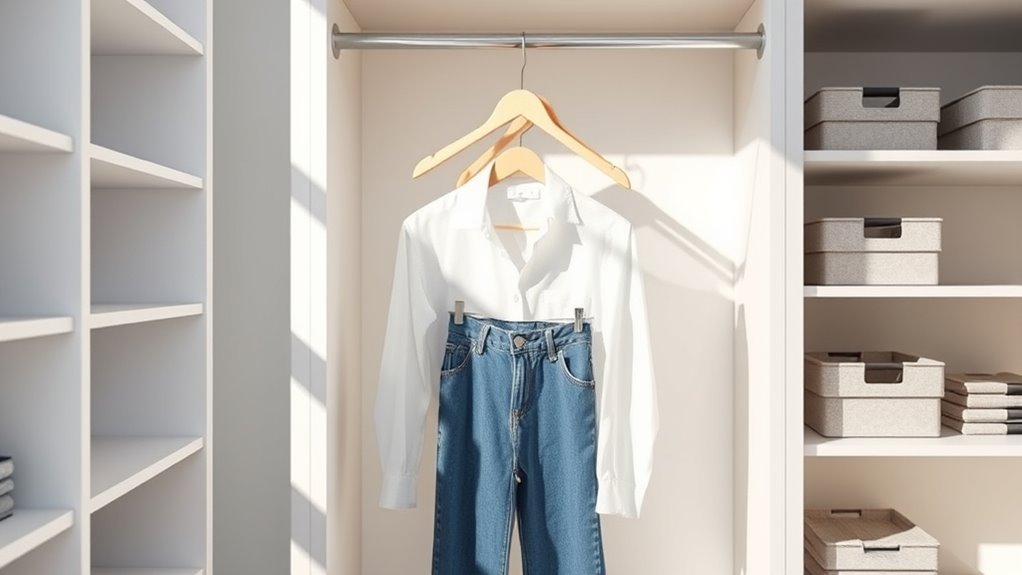The One‑In, One‑Out Rule helps you prevent clutter by only bringing in new items when you remove an existing one. It encourages you to evaluate each addition carefully, making sure everything serves a purpose. This simple practice shifts your focus from accumulation to intentional living, creating a calm, organized space. Keep applying this rule consistently, and you’ll discover more tips to maintain a clutter-free environment that reflects your values.
Key Takeaways
- Minimalists apply the rule by removing an item for every new one they bring in, preventing clutter buildup.
- It encourages intentional purchasing, ensuring each new item adds value and aligns with personal priorities.
- Digital decluttering complements the rule, involving deleting files or apps when adding new ones.
- The rule promotes mindful evaluation of needs versus wants before acquiring anything.
- Over time, it fosters a minimalist mindset, reducing impulsive accumulation and maintaining an organized, serene environment.

The One‑In, One‑Out Rule is a simple but effective way to manage clutter and maintain organization. It encourages you to evaluate each new item before bringing it into your space, guaranteeing that you only add if you’re willing to remove something existing. This approach is particularly valuable if you’re cultivating a minimalist mindset, which emphasizes intentionality, simplicity, and reducing excess. When you apply this rule, you actively prevent clutter from accumulating, making your environment more serene and easier to maintain. Incorporating digital decluttering as part of this habit further enhances your overall organization and sustainability. Digital decluttering is a vital aspect of this process. It’s easy to collect digital files, emails, apps, and subscriptions without realizing how much it adds up. By adopting the one-in, one-out principle in your digital life, you keep your devices streamlined and clutter-free. For example, when you download a new app, you might delete an old one that no longer serves you. Similarly, deleting unnecessary emails or organizing files into specific folders ensures your digital workspace remains tidy. This ongoing process prevents digital clutter from overwhelming you, helping you stay focused and efficient.
Incorporating the one-in, one-out rule with a minimalist mindset shifts your perspective from accumulation to intentional consumption. Instead of impulsively acquiring new items—whether physical or digital—you pause and ask yourself if the new item truly adds value. If it does, you commit to letting go of something comparable. This mindset reinforces the idea that less is more, and it helps you develop a more conscious approach to what you allow into your space. Over time, this habit can reshape your entire environment, making it easier to maintain clarity and calmness.
Applying this rule isn’t about deprivation; it’s about mindful management. You recognize that every addition has a trade-off, and by practicing one-in, one-out, you actively control the flow of possessions. You create a balance that prevents clutter from taking over your home and digital life. It’s a way to honor your space and your time, ensuring that each item or file serves a purpose. This deliberate approach supports your broader goal of living intentionally, making sure your environment reflects your values and priorities.
Ultimately, the one-in, one-out rule fosters a sense of control and peace. It simplifies decision-making and keeps your surroundings aligned with your minimalist mindset. When you consistently practice this principle, you’ll find it easier to maintain an organized, clutter-free life. Whether physical or digital, this habit helps you focus on what truly matters, creating more room for the things that bring you joy and purpose.
Frequently Asked Questions
How Do Minimalists Handle Sentimental Items?
When handling sentimental items, you focus on emotional attachment and memory preservation. You choose to keep only those items that truly hold special meaning, avoiding unnecessary clutter. By selecting a few meaningful pieces, you honor your memories without overwhelming your space. You might photograph or create a digital archive of keepsakes, ensuring their significance remains intact while decluttering physically. This mindful approach helps you cherish memories without cluttering your life.
Can the One-In, One-Out Rule Apply to Digital Clutter?
Did you know that the average person spends over 2 hours daily managing digital clutter? Applying the one-in, one-out rule to digital organization helps keep your online storage tidy and manageable. When you add new files, delete or archive existing ones, ensuring your digital space stays clutter-free. This simple habit prevents overwhelm, saves time, and maintains a streamlined, efficient digital environment—just like minimalists do with their physical belongings.
What if I Rarely Buy New Things?
If you rarely buy new things, focus on optimizing your storage solutions to keep what you already own organized and accessible. Your shopping habits are minimal, so instead of constantly acquiring more, prioritize maintaining what you have. Regularly reassess your belongings, donate items you no longer need, and make certain your space stays clutter-free. This approach helps you stay minimalist without needing the one-in, one-out rule, since your purchases are infrequent.
How Strict Should I Be With the Rule?
You might think strict rules are unnecessary since you rarely buy new things, but being too lax can lead to clutter. To avoid decluttering challenges, consider a flexible approach—perhaps only replacing essential items or using smart storage solutions. This way, you keep your space organized without feeling overwhelmed. Staying consistent, even loosely, helps maintain your minimalist goals and prevents clutter from creeping back in.
Does This Rule Work for Shared Household Spaces?
In shared household spaces, the one-in, one-out rule can work well if everyone shares responsibilities and agrees on household organization. You should communicate clearly about decluttering goals and set expectations with your housemates. By involving everyone, you guarantee consistency and fairness, making it easier to maintain a clutter-free environment. Regular check-ins help keep everyone accountable and support a harmonious, organized living space for all.
Conclusion
By embracing the one-in, one-out rule, you gently clear the shelves of life’s clutter, making space for what truly matters. Each new item finds its place, whispering that less can be more, like a tidy garden blooming with purpose. As you cultivate simplicity, your surroundings become a sanctuary of calm and clarity, where every thing has a home. In this quiet balance, you discover the beauty of letting go and welcoming serenity.









